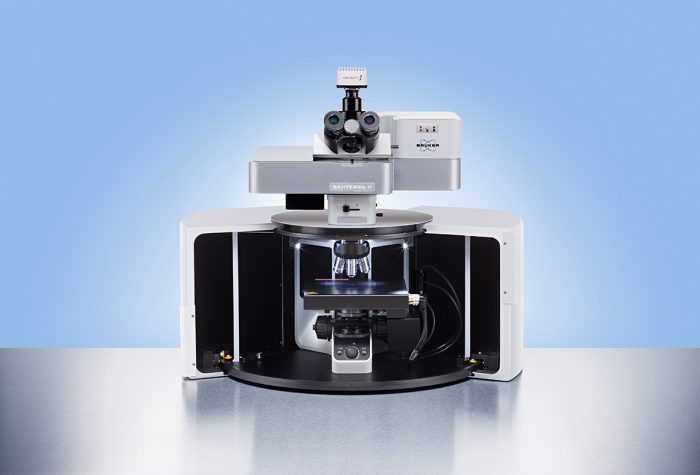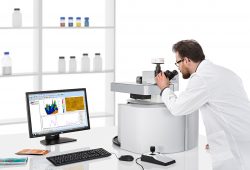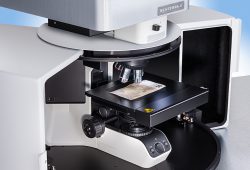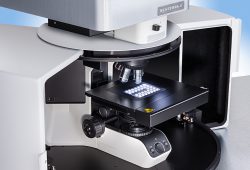Raman Microscope SENTERRA II
Description
The SENTERRA II is a confocal Raman microscope designed for straightforward, non-stop operation. Its high degree of automation allows fast and easy Raman imaging for failure analysis, quality control and scientific research.
Automation is the SENTERRA II’s key feature. It allows the user to concentrate on the essential things: the analytical problem, the Raman measurement and more importantly, the results.
SENTERRA II provides:
- Smooth user experience
- Research-grade performance
- Superb wavenumber precision
- Self-diagnosis and automated OQ/PQ
- Virtually maintenance-free operation
- 100% GMP & 21 CFR p11 compliance
Reproducibility, Precision and User-Safety in Raman Microscopy
The SENTERRA II is fully automated including self-diagnosis and instrument tests like OQ and PQ. Change a laser by a simple mouse-click and afterwards, filter and grating are adjusted automatically.
To use this automation to its full extent, Bruker rethought calibration and created the patented SureCalTM technology. It continuously recalibrates the device and allows permanent sub-wavenumber precision.
It’s about user safety – especially when beginners or students are involved. A class 1 laser housing and interlock always protects the user of any harmful laser radiation
Features
SENTERRA II technical features:
- Fully automated hardware
- One-click switching of 4 built-in lasers
- SureCalTM calibration technology
- Fast 3D Raman imaging
- Automate your own workflows in minutes
- Powerful analysis and identification tools
- FT-Raman for minimized fluorescence in
- combination with FTIR instrumentation
SureCal Continuous Raman Calibration Technology
Naturally, the SENTERRA II offers excellent sensitivity combined with pristine spectral and Raman Imaging performance. But the real powerhouse of this confocal Raman microscope is our SureCalTM technology.
Let us briefly repeat one of the most important principles of Raman technology: External factors affect the optical and mechanical components in every Raman microscope, especially heat, component changes and vibrations. Ultimately, this induces wavenumber shifts, which must be compensated by regular recalibrations.
Thanks to SureCalTM, the SENTERRA II is the only Raman microscope that is always calibrated. Don’t waste your valuable time with recalibration – start analyzing. No matter if it is a quick material identification or the collection of large data sets for PCA or other statistical methods.
Applications
Art Conservation & Restoration
Historical works of art are precious and to conserve a part of human history is an exciting endeavor. The SENTERRA II is applied in the restoration of historical paintings, buildings and artwork. It offers additional tools like Raman probes and can be mounted on a gantry to cover and analyze larger paintings.
Forensic
From the examination of potentially counterfeit art objects to varnish analyses in crime labs. Raman microscopy provides precise information about the chemical identity and origin of unknown substances. Due to the high spatial resolution down to the nanometer range, even smallest secrets are uncovered.
Pharmaceuticals
Early on, Bruker decided address the needs of pharmaceutical companies. Therefore, SENTERRA II and OPUS and are 100% compliant with GMP and all major pharmacopoeias, 21 CFR part 11 and also follow the ALCOA+ principle. Whether locally or on a server, the SENTERRA II ensures the integrity and security of your data.
Plastics
Polymers are indispensable and Raman microscopy can provide crucial insights into the quality control and development of plastic products. While Raman imaging yields information on material distribution, dedicated spectral libraries allow the identification of unknown materials and fillers.
Material Science
Whether battery research or studies of graphene or silicon – Raman microscopy is extensively used by material scientists. The SENTERRA II supports you with utmost precision and offers up to three excitation lasers as well as an optional coupling to FT-Raman for minimized fluorescence.
Environmental Studies
One of the many environmental applications is the analysis of microplastics. Again, the high spatial resolution of Raman microscopy offers significant advantages when smallest microplastic (MP) particles needs to be resolved. Automated particle identification routines enable fast and reliable analysis of MP contamination












